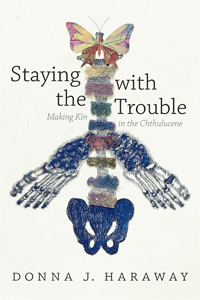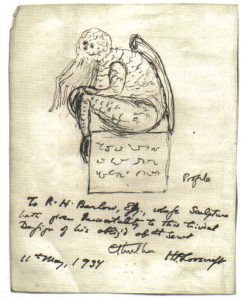Savage Minds welcomes guest blogger Cthulhu, Great Old One and Special Collections Librarian at Brown University.
When the puny mortals at Savage Minds invited me to review the latest work by Donna Haraway I was perplexed. After I had devoured the sanity of their pathetic messenger, I turned the book over in my tentacles. “Chthulucene,” eh? Was this meant to be a literary subversion of the Anthropocene, supplanting the implied anthropocentrism of that category with something alien and indifferent? And if so, was this really a wise move, politically speaking, when the purpose of the term was to draw attention to human actions that frequently remained hidden to those without the all seeing eyes of Yog-Sothoth? Needless to say, I was intrigued.

Full disclosure: Haraway and I are somewhat estranged. She never forgave me for guiding my cultists to infect Sumatran rat-monkies with a zombie virus (for more on this consult the 1992 documentary Dead Alive). Sure my methods are “controversial” but she and I have the same goal in mind: confronting our shared ecological crisis by addressing the problem of accelerating human population growth. Whereas she seeks to carve out the possibility that feminism can navigate the racist and eugenicist histories of limiting human reproduction, I advocate for a strategy of direction action, i.e. human sacrifice.
Our professional disagreements not withstanding I gave her latest monograph a fair reading. At just 168 pages exclusive of endnotes Staying with the Trouble is Haraway at her most accessible. Readers familiar with her work with recognize her characteristic style and language, polysemous metaphors co-mingle with evocative refrains, deep etymological readings, and even the occasional sentence with internal rhyme schemes. Some will argue that word games will only take you so far and, to be frank, I am sympathetic to this critique. Unlike her most rigorous works, Staying with the Trouble can get vague and repetitive. I mean, its not The Necronomicon.
While “Tentacular Thinking” probably won’t replace “Cyborg Manifesto” in your theory sylabus it must be recognized that this was never the author’s intent. This is a work to provoke and inspire. It is a call to arms (or pseudopods as the case may be)! Thus to judge it in the terms it sets out for itself, the book is a success.
Let us delve into some of the details, begining with why I was summoned here. What is this Chthulucene? Monsters are a warning. Like the word “demonstrate” with which it shares an identical root, we are here to show. Haraway mistakenly believes she has inoculated herself against my minions by adding a superfluous “h” to Cthulhu in order to make her Chthulucene but yet I linger! Haraway herself denies this. Sadly and on multiple ocassions, in the text and in the notes, she lashes out against me – personally – calling me racist and misogynistic. This is not true. I am indifferent to everyone’s suffering equally.

Just as I sleep under the ocean, dead but dreaming in the city of R’leyh, the Chthulucene represents what comes from under. Invertibrates of all kinds abound, spiders and octopus especially, but it is bacteria that best embody this. (In an egregious oversight, Haraway fails to cite the Elder Things who created the slave race of shoggoths accidentally spawning bacteria and, hence, all life on Earth.) In other passages Haraway uses the Chthulucene to invoke indigeneity and the continuing struggles of native peoples for autonomy. At yet other times it takes on a quasi-spiritual and mythological mantle as she evokes Gaia and Medusa. A God Trick in reverse, perhaps? In short the Chthulucene is like an ecological unconscious, underneath it all but without necessarily being foundational in a teleological sense, constantly running in the background whether you care to notice it or not, a Lacanian “Real” that resists being made intelligible.
Another important trope in Staying with the Trouble are String Figures. These join Haraway’s growing list of SF phrases going back to her earliest publications: science fiction, science fact, speculative feminism, etc. Moreover the Cat’s Cradle, a classic string game, fits perfectly into her career interest in webs and weaving. In this case what makes the String Figure so effective as a metaphor to think with is the way in which they can embody exchange, collective creation, and storytelling, crisscrossing like the moist tentacles dripping from my gaping maw.
By now you’re all familiar with the Multispecies turn (can we call it a “turn” yet?) the proactive rethinking of scientific and humanities inquiry beyond the human. Frankly this poststructural evolutionary ecology is still incomplete as it has failed to account for Azathoth, his sons, and the elder races of aliens. But Haraway, citing Latour, remains resolute in her instance that you mortals stay “earthbound.” Haraway is, of course, at the vanguard of this Multispecies moment but here she outlines her objection to the so-called “posthuman,” calling instead for the “compost.” Like the ticklish extended title of Modest Witness it is a smart joke, punning on posts. Compost is meant to convey the importance of death to life and how life rises out of death. As an expert on death I must concur. You all need to die.
Compost and the possibility of life coming from death is a key to what the author refers to as “ongoingness” (a productive alternative to philosophical discourses of “becoming”). For Haraway the key to unlocking an ongoingness that is more than mere survival is something she calls sympoiesis, or making with. Sympoiesis invites us to think beyond individualism to relationships, relations with relatives, human and not. String Figures can be a sympoesis because they are something you make with another. Kinship is sympoesis.
Haraway:
We need to make kin symchthonically, sympoetically. Who and whatever we are, we need to make-with — become-with, compose-with — the earth-bound. (p.102)
Haraway makes her case with theory and scholarship in the first 100 pages, following this up with three chapters of case studies. By way of conclusion the book finishes with a chapter not inaccurately described as fanfic. Throughout she relies heavily on the work of Anna Tsing, especially her recent Mushroom at the End of the World, with backing roles played by Latour, Le Guin, Strathern, Viveiros de Castro, Stengers, and Despret. As the god of an evil cult, one thing that I strongly identified with was Haraway’s reconception of theory and writing as something like magic. How else would you describe a worldview where the practice of thinking can have such transformative effective? Bizarre supernatural forces bend with realism. A world once inhabited by another race who was cast out and yearns to return. Unseen presences. Unspeakable names. There must be a reason she keeps repeating the same things over and over again! It is more than a refrain, it is a chant! These are merely a few of the reasons I am skeptical that she did not mean to summon me by speaking my name, extra-H or no.
Bloody marvelous! I would love to see similar reviews from, say, the perspectives of fire ants or roaches.
Wow. Best post on Savage Minds since 2008. Loved it!
Ph’nglui mglw’nafh Cthulhu R’lyeh wgah’nagl fhtagn
Hands down my most favorite review I’ve ever read! Brilliant!
This review is brave, brilliant and spot on in terms of illuminating the main tangled-yet-tenacious tentacular thinking and evoking going on in Haraway’s latest book. She seems to also marry/meld the Cyborg and the Goddess as gathering Figures more than ever. An encantation – not without some editorial blips – of where Haraway is going (com)post WHEN SPECIES MEET, and how she invites us to join her. If not intellectually, certainly intuitively.
Good review, however, I would have liked to see some focus on Haraway’s focus on apocolyptic futures and how in order to ‘stay with the trouble’ we must look for multi species kin practices. The both human and nonhuman aspect of this is in relation to Actor-network Theory, assemblage theory, etc. I thought it played a pivotal role in how she constructed String Figures as a metaphoric tool of analysis and her use of Sympoesis. I also had this feeling, as I was flipping through Haraway’s book, that she was operationalizing a lot of ANT’s insights in a way that could inspire transformative practices in a time where hope is dwindling for many people.
I quite liked the book, the theory, and it’s playful writing.